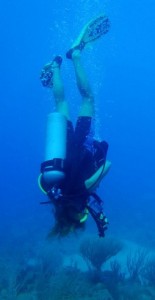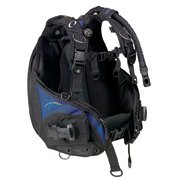If you haven’t already done so, take a look at my introduction to Understanding Air and its Relationship to 5 Key Areas to Scuba Diving prior to reading this post to give yourself some quick and helpful background information! In this post I will discuss the BCD, its correlation with air, some helpful tips, and then my personal equipment recommendation. If you enjoy this article – let me know and stay tuned for the next 4 posts on how Air relates to Ears, Mask, Tank & Octopus, and your Lungs & Breathing!
The first specific area I’d like to talk about is the BCD or Buoyancy Control Device. Divers wear this piece of equipment, which contains a bladder to hold air, like a jacket or vest. Your BCD is connected to the air in your tank via the “Low Pressure Inflator Hose”. It is also equipped to be “orally inflated” should there be a problem with the mechanism to add air from the tank. You do this by blowing into the hose while holding down the deflate button (which opens the valve to allow air in/out).
Before you jump in the water you always make sure your BCD is partially inflated so that you can float on the surface. When you are ready to go underwater you raise the Low Pressure Inflator Hose high above your head and release all the air from the BCD and exhale slowly, which also releases air from your lungs to assist in your descent. As you come close to the bottom or the depth that you want to stay at, you will usually need to add some air into the BCD to prevent you from continuing down or hitting the bottom.
This tends to take a few dives as you learn the balancing act of how much air will maintain your general position at a certain depth. Remember, the air that is put into your BCD is also affected by the pressure and becomes increasingly more (and less!!) dense depending on your depth. That means that the amount of air you need to maintain neutral (neither sinking nor floating) buoyancy at 10m/32ft will be different than what you put in at 23m/75ft, for example. This also means that when you change your depth by swimming over a reef or to a shallower depth, you must make adjustments to the amount of air inside the BCD by releasing air – even if you didn’t add any more air to it!!
This happens because just as going deeper causes the air to be more dense, ascending (even just a metre or 3 feet) will cause the air to expand and make your BCD fuller causing you to float upwards until you release the air, which results in a balance of just enough air inside the BCD to achieve neutral buoyancy at that specific depth. This is a kind of balancing act that at first takes some thought and will later become second nature to you. Remember this important point – Upon ascent, consider that the air already inside your BCD will expand, so pay attention to your positioning and if you begin to float upwards. Be prepared to release the air to balance it out and to avoid an uncontrolled ascent.
Mia’s helpful tips!
1. Before diving and during your pre-dive equipment check, with the air turned on, practice putting air into the BCD and taking it out (inflate and deflate). Sometimes it can be confusing when using rental gear on which button is which. You can also practice orally inflating.
2. While underwater, if you are trying to locate your Low Pressure Inflator Hose to inflate/deflate, always remember: “If I touch my LEFT BOOB, I will find it!!!” Anyone want to admit to trying to deflate their snorkel at some point of their diving career!!!???
3. Having trouble deflating? Air will always stay at the highest point as it rises. If you are in a horizontal position, slightly head-first, that means the air could be sitting in the bottom part of your BCD as your bum will be higher than your shoulders. Try to make it easy for the air to escape from your Inflator Hose by:
a. Always raise the hose as high above your head as possible.
b. Sometimes you can even adjust your positioning in the water from horizontal to momentarily vertical to further assist the escape of air from the Inflator hose as you reach up.
c. If for some reason you are head-first and your fins are high above you, this means any air in your BCD will actually be in the bottom of your jacket. Most BCDs come with a “Dump valve” to release air from a head-first position underwater. Feel around the bottom edge of your BCD for the cord and a little tug should allow a burst of air to escape.
4. Little by Little! Try to avoid the up and down ping-pong effect by thoughtfully inflating/deflating only a little, waiting for a result and then repeating as necessary. As a beginner diver learning this fancy balancing act called buoyancy, stay calm if you feel yourself floating up upon ascent. Remember to exhale completely as you release just a puff of air. Many divers have felt a quick twinge of panic at floating up and proceed to do a big dump of air causing them to drop back down, but too quickly and beyond their intended neutral zone into a “negative buoyancy” (sinking). This results in more fiddling of inflating again to achieve the comfortable hovering position.
5. Make a commitment to get to know yourself! Adding air to your BCD is not something you should typically be doing throughout the entire dive. Remember that your buoyancy is not only controlled by your BCD, but ALSO by your breathing. Make a commitment that on each dive once you achieve neutral buoyancy (neither sinking, nor floating) at a depth you will stay at for awhile, practice using your breathing to adjust your position in the water. Refer to the post on your Lungs & Breathing blog to come in a few weeks! Buoyancy is something that you will practice over and over again and WILL get! Have patience, get familiar with your BCD and enjoy!
Mia’s BCD Recommendation!
The BCD I use now and absolutely love is called the “Hera” by Oceanic and created specifically for women. It is both a jacket style and rear inflation form, which I love because I am stable in both horizontal and vertical positioning without back weights (although pockets for back weights are available if I want). It also has a ton of sturdy D rings to attach my Alternate Air Source and attach my Surface Marker Buoy alongside big pockets to store a slate or some yucky plastic bottle I find underwater and want to put in the trash. Before the “Hera” I used the Seaquest “Diva” for many years and loved, but I decided against the newer version of this due to my desire to leave rear-inflation styled BCDs and the lack of pockets and D-rings. Sorry Diva you were good, but time to move on!
Feel free to send me a message via Contact Mia if you have any questions regarding this topic. If you “Like” it make sure you let me know on my Facebook page DiveWithMia!
Happy Diving!


